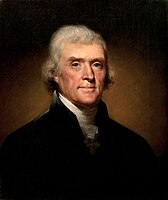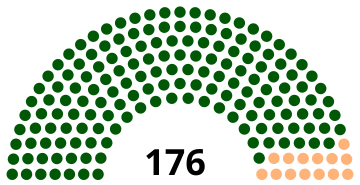For related races, see 1804 United States elections.
| |||||||||||||||||||||||||||||
176 members of the Electoral College 89 electoral votes needed to win | |||||||||||||||||||||||||||||
|---|---|---|---|---|---|---|---|---|---|---|---|---|---|---|---|---|---|---|---|---|---|---|---|---|---|---|---|---|---|
| Turnout | 23.8% | ||||||||||||||||||||||||||||
| |||||||||||||||||||||||||||||
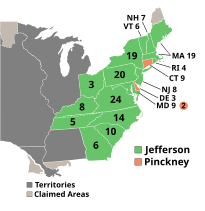 | |||||||||||||||||||||||||||||
| |||||||||||||||||||||||||||||
Presidential elections were held in the United States from November 2 to December 5, 1804. Incumbent Democratic-Republican president Thomas Jefferson defeated Federalist Charles Cotesworth Pinckney of South Carolina. It was the first presidential election conducted following the ratification of the Twelfth Amendment to the United States Constitution, which reformed procedures for electing presidents and vice presidents.
Jefferson was renominated by his party's congressional nominating caucus without opposition, and the party nominated Governor George Clinton of New York to replace Aaron Burr as Jefferson's running mate. With former president John Adams in retirement, the Federalists turned to Pinckney, a former ambassador and Revolutionary War hero who had been Adams's running mate in the 1800 election.
Though Jefferson had only narrowly defeated Adams in 1800, he was widely popular due to the Louisiana Purchase and a strong economy. He carried almost every state, including most states in the Federalist stronghold of New England.
Background
Although the 1800 presidential election was a close one, Jefferson steadily gained popularity during his term. American trade boomed due to the temporary suspension of hostilities during the French Revolutionary Wars in Europe, and the Louisiana Purchase was heralded as a great achievement.
Nominations
Democratic-Republican Party nomination
 | |||||||||||||||||||||||||||||
| Thomas Jefferson | George Clinton | ||||||||||||||||||||||||||||
|---|---|---|---|---|---|---|---|---|---|---|---|---|---|---|---|---|---|---|---|---|---|---|---|---|---|---|---|---|---|
| for President | for Vice President | ||||||||||||||||||||||||||||

|
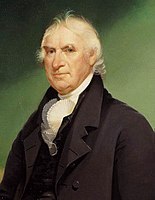 | ||||||||||||||||||||||||||||
| 3rd President of the United States (1801–1809) |
1st Governor of New York (1777–1795, 1801–1804) | ||||||||||||||||||||||||||||
The congressional nominating caucus of the Democratic-Republican Party was held in February 1804, with 108 members of the United States Congress in attendance and Senator Stephen R. Bradley as its chair. Jefferson was renominated by acclamation while Vice President Aaron Burr was not considered for renomination. The caucus selected to give the vice-presidential nomination to Governor George Clinton whose main opponent was Senator John Breckinridge. A thirteen-member committee was selected to manage Jefferson's presidential campaign.
Vice-presidential candidates
- John Breckinridge (Kentucky), U.S. Senator
- George Clinton (New York), Governor
- Gideon Granger (Connecticut), Postmaster General
- John Langdon (New Hampshire), former U.S. Senator
- Levi Lincoln (Massachusetts), U.S. Attorney General
- William Maclay (Pennsylvania), former U.S. Senator
-
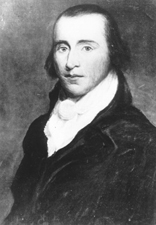 Senator
Senator
John Breckinridge
from Kentucky -
 Governor
Governor
George Clinton
of New York -
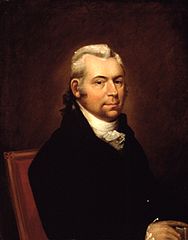 Postmaster General
Postmaster General
Gideon Granger
from Connecticut -
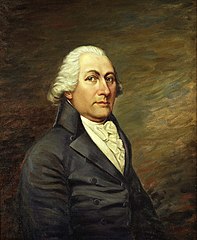 Former Senator
Former Senator
John Langdon
from New Hampshire -
 Attorney General
Attorney General
Levi Lincoln
from Massachusetts -
 Former Senator
Former Senator
William Maclay
from Pennsylvania
Balloting
| Presidential ballot | Total | Vice-presidential ballot | Total |
|---|---|---|---|
| Thomas Jefferson | 108 | George Clinton | 67 |
| John Breckinridge | 20 | ||
| Levi Lincoln | 9 | ||
| John Langdon | 7 | ||
| Gideon Granger | 4 | ||
| William Maclay | 1 |
Federalist Party nomination
 | |||||||||||||||||||||||||||||
| Charles Cotesworth Pinckney | Rufus King | ||||||||||||||||||||||||||||
|---|---|---|---|---|---|---|---|---|---|---|---|---|---|---|---|---|---|---|---|---|---|---|---|---|---|---|---|---|---|
| for President | for Vice President | ||||||||||||||||||||||||||||
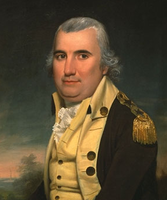 |
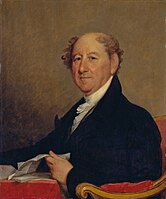 | ||||||||||||||||||||||||||||
| 6th
U.S. Minister to France |
3rd
U.S. Minister to Great Britain | ||||||||||||||||||||||||||||
The Federalists did not hold a nominating caucus, but Federalist congressional leaders informally agreed to nominate a ticket consisting of Charles Cotesworth Pinckney of South Carolina and former Senator Rufus King of New York. Pinckney's public service during and after the American Revolutionary War had won him national stature, and Federalists hoped that Pinckney would win some Southern votes away from Jefferson, who had dominated the Southern vote in the previous election.
General election
Federalist leader Alexander Hamilton's death in July 1804 following the Burr–Hamilton duel destroyed whatever hope the Federalists had of defeating the popular Jefferson. Leaderless and disorganized, the Federalists failed to attract much support outside of New England. The Federalists attacked the Louisiana Purchase as unconstitutional, criticized Jefferson's gunboat navy, and alleged that Jefferson had fathered children with his slave, Sally Hemings, but the party failed to galvanize opposition to Jefferson. Jefferson's policies of expansionism and reduced government spending were widely popular. Jefferson was aided by an effective Democratic-Republican party organization, which had continued to develop since 1800, especially in the Federalist stronghold of New England.
Jefferson's victory was overwhelming, and he even won four of the five New England states. Pinckney won only two states, Connecticut and Delaware. This was the first election where the Democratic-Republicans won in Maryland, Massachusetts, New Hampshire, and Rhode Island.
As of 2024, Jefferson was the first of eight presidential nominees to win a significant number of electoral votes in at least three elections, the others being Henry Clay, Andrew Jackson, Grover Cleveland, William Jennings Bryan, Franklin D. Roosevelt, Richard Nixon, and Donald Trump. Of these, Jackson, Cleveland, and Roosevelt also won the popular vote in at least three elections. Jefferson, Cleveland, Roosevelt, and Trump were also their respective party's nominees for three consecutive elections.
Results
| Presidential candidate | Party | Home state | Popular vote | Electoral vote |
Running mate | |||
|---|---|---|---|---|---|---|---|---|
| Count | Percentage | Vice-presidential candidate | Home state | Electoral vote | ||||
| Thomas Jefferson (incumbent) | Democratic-Republican | Virginia | 105,524 | 73.2% | 162 | George Clinton | New York | 162 |
| Charles C. Pinckney | Federalist | South Carolina | 38,519 | 26.7% | 14 | Rufus King | New York | 14 |
| Unpledged electors | None | N/A | 95 | 0.1% | 0 | N/A | N/A | 0 |
| Total | 144,138 | 100% | 176 | 176 | ||||
| Needed to win | 89 | 89 | ||||||
Source (Popular Vote): A New Nation Votes: American Election Returns 1787-1825
Source (electoral vote): "Electoral College Box Scores 1789–1996". National Archives and Records Administration. Retrieved July 30, 2005.
Only 11 of the 17 states chose electors by popular vote.
Those states that did choose electors by popular vote had widely varying restrictions on suffrage via property requirements.
Popular vote by state
The popular vote totals used are the elector from each party with the highest total of votes. The vote totals of North Carolina and Tennessee appear to be incomplete.
| State | Thomas Jefferson
Democratic-Republican |
Charles C. Pinckney
Federalist |
Other | Margin | Citation | ||||
|---|---|---|---|---|---|---|---|---|---|
| # | % | # | % | # | % | # | % | ||
| Kentucky | 5,080 | 100.00% | No ballots | No ballots | 5,080 | 100.00% | |||
| Maryland | 7,304 | 75.92% | 2,306 | 23.97% | 11 | 0.11% | 4,987 | 51.84% | |
| Massachusetts | 29,599 | 53.58% | 25,644 | 46.42% | 2 | <0.01% | 3,953 | 7.16% | |
| New Hampshire | 9,088 | 52.01% | 8,386 | 47.99% | 0 | 0.00% | 702 | 4.02% | |
| New Jersey | 13,119 | 99.79% | 19 | 0.14% | 8 | 0.06% | 13,092 | 99.59% | |
| North Carolina | 1,644 | 486 | No ballots | ||||||
| Ohio | 2,593 | 87.69% | 364 | 12.31% | No ballots | 2,229 | 75.38% | ||
| Pennsylvania | 22,081 | 94.69% | 1,239 | 5.31% | No ballots | 20,842 | 89.38% | ||
| Rhode Island | 1,312 | 100.00% | No ballots | No ballots | 1,312 | 100.00% | |||
| Tennessee | 778 | 100.00% | No ballots | No ballots | |||||
| Virginia | 12,926 | 98.86% | 75 | 0.57% | 74 | 0.57% | 12777 | 97.72% | |
| |||||||||||||||||||||||||
| ||||||||||||||||||||
States that flipped from Federalist to Democratic-Republican
Close states
States where the margin of victory was under 5%:
- New Hampshire, 4.02% (702 votes)
States where the margin of victory was under 10%:
- Massachusetts, 7.16% (3,953 votes)
Maps
-
 Electoral College map
Electoral College map
-
 Map of presidential election results by county, shaded according to the vote share of the highest result for an elector of any given candidate (includes rejected votes)
Map of presidential election results by county, shaded according to the vote share of the highest result for an elector of any given candidate (includes rejected votes)
-
 Map of presidential election results by electoral district, shaded according to the vote share of the highest result for an elector of any given candidate. Electoral boundaries for Maryland could not be found (includes rejected votes)
Map of presidential election results by electoral district, shaded according to the vote share of the highest result for an elector of any given candidate. Electoral boundaries for Maryland could not be found (includes rejected votes)
Electoral College selection
| Method of choosing electors | State(s) |
|---|---|
| Each elector appointed by state legislature | |
| Each elector chosen by voters statewide | |
| State is divided into electoral districts, with one elector chosen per district by the voters of that district | |
|
State is divided into two electoral districts and half the electors are chosen from each district. |
Kentucky |
|
Massachusetts |
See also
- Bibliography of Thomas Jefferson
- History of the United States (1789–1849)
- Second inauguration of Thomas Jefferson
- 1804–05 United States House of Representatives elections
- 1804–05 United States Senate elections
Notes
- Unpledged elector John Bradley is reported with 1 vote in the town of Concord but is shown with no votes in the final official count. Similarly, the town of Portsmouth is reported with 27 votes under "scattering"
- ^ Only complete returns for the 8th and 10th electoral districts exist. Incomplete returns from the 3rd and 14th electoral districts also exist.
- ^ The Sheriffs of Currituck, Franklin, Martin, and Montgomery Counties failed to attend and compare the polls at the time and place appointed. This led to votes of these counties being rejected. Of the known rejected votes there were (best performing electors only) 258 Jefferson and 669 Pinckney votes. The rejection of these votes caused the 8th and 10th electoral districts to switch the winner from a Pinckney elector to a Jefferson elector. Also, the best performing Jefferson elector in the 8th electoral district switched from being Isaac Lanier to Robert Cochran
- Returns only exist for the 5th electoral district
References
- "National General Election VEP Turnout Rates, 1789-Present". United States Election Project. CQ Press.
- ^ Deskins, Donald Richard; Walton, Hanes; Puckett, Sherman (2010). Presidential Elections, 1789-2008: County, State, and National Mapping of Election Data. University of Michigan Press. pp. 41–42.
- National Party Conventions, 1831-1976. Congressional Quarterly. 1979.
- Zahniser, Marvin (1967). Charles Cotesworth Pinckney: Founding Father. University of North Carolina Press. pp. 243–246.
- "A New Nation Votes". elections.lib.tufts.edu.
- "A New Nation Votes". elections.lib.tufts.edu. Retrieved October 3, 2020.
- "A New Nation Votes". elections.lib.tufts.edu. Retrieved October 3, 2020.
- "A New Nation Votes". elections.lib.tufts.edu. Retrieved October 3, 2020.
- "A New Nation Votes". elections.lib.tufts.edu. Retrieved October 3, 2020.
- "A New Nation Votes". elections.lib.tufts.edu. Retrieved October 3, 2020.
- "A New Nation Votes". elections.lib.tufts.edu. Retrieved October 3, 2020.
- "A New Nation Votes". elections.lib.tufts.edu. Retrieved October 3, 2020.
- "A New Nation Votes". elections.lib.tufts.edu. Retrieved October 3, 2020.
- "A New Nation Votes". elections.lib.tufts.edu. Retrieved October 3, 2020.
- "A New Nation Votes". elections.lib.tufts.edu. Retrieved October 3, 2020.
- "A New Nation Votes". elections.lib.tufts.edu. Retrieved October 3, 2020.
- "A Historical Analysis of the Electoral College". The Green Papers. Retrieved March 20, 2005.
- A New Nation Votes: American Election Returns 1787-1825
- Presidential Election of 1804: A Resource Guide from the Library of Congress
External links
- Election of 1804 in Counting the Votes Archived September 30, 2019, at the Wayback Machine
| (← 1800) 1804 United States presidential election (1808 →) | |||||
|---|---|---|---|---|---|
| Democratic-Republican Party |
| ||||
| Federalist Party |
| ||||
| State results of the 1804 U.S. presidential election | ||
|---|---|---|
| Candidates |  | |
| General articles | ||
| Local results | ||
| Other 1804 elections | ||
| Federalist Party | |||||||||||
|---|---|---|---|---|---|---|---|---|---|---|---|
| Presidential tickets | |||||||||||
| U.S. House speakers |
| ||||||||||
| U.S. Cabinet |
| ||||||||||
